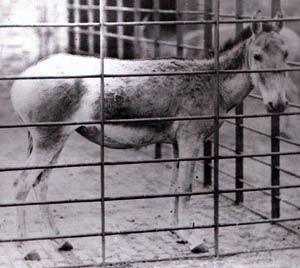Equus hemionus hemippus I. Geoffroy Saint-Hilaire, 1855
Syrian wild ass, Syrian onager, Assyrian onager, Hemippe, Achdari
Taxonomy & Nomenclature
Synonym/s: Equus hemippus I. Geoffroy Saint-Hilaire, 1855 (original combination); Equus onager hemippus Saint-Hilaire, 1855; Equus hemionus syriacus Milne-Edwards, 1869
Conservation Status
Extinct
Last record: 1927 or 1928 (see Notes)
IUCN RedList status: Extinct
The smallest of the equids, adults stood roughly 1m at the withers (i.e. shoulders). It's extinction was caused largely due to excessive hunting of its herds. It has been hypothesised that motor vehicles may have become available to local hunters before its disappearance and that this may have been a "factor", and the last nail in the coffin of the species (Harper, 1945).
The last known wild individual was shot at the Al Ghams oasis, Lake Azrak, northern Arabia in 1927. An individual in the Vienna zoo died later that year. However, (Antonius, 1928) states that an individual survived in the Vienna zoo until 1928. This means that either the individual which died in 1927 in the same zoo did not in fact die until 1928. Or perhaps there were two individuals, one each dying in the years 1927 and 1928 respectively.
Lots of extra information, photographs and links can be found here (ProBoards Forum).
Distribution & Habitat
"[from] Syria south into the Arabian Peninsula"
Biology & Ecology
Hypodigm
MCZ 6345
2 specimens are in the British Museum
Media
Photographs
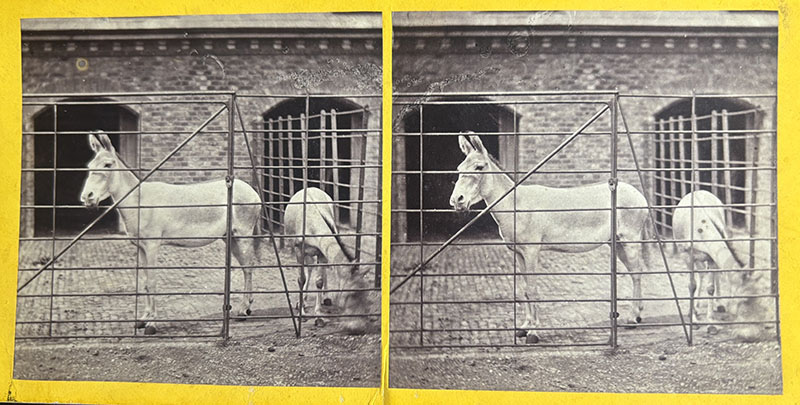
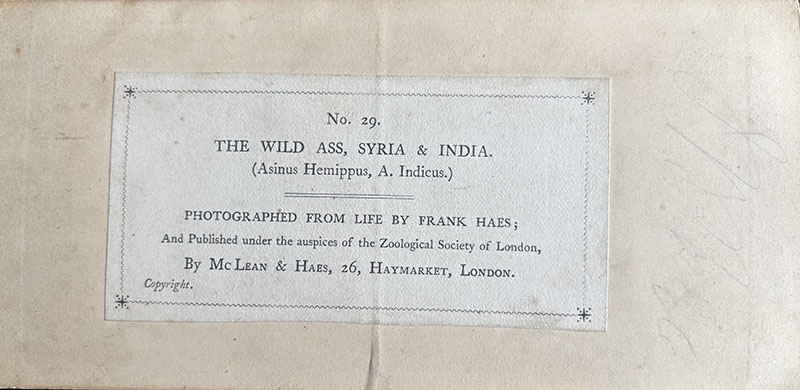
Above: London Zoo (note that the Syrian wild ass is actually on the right of frame contrary to the labelling on the rear). Front and back of stereoview No. 29 by Frank Haes from his first series (No. 1 to No. 55) of 1864. Held in a private collection. Photo: Ken Wallis. Reproduced with permission.
Above: London Zoo, photograph by Frederick York c.1872.
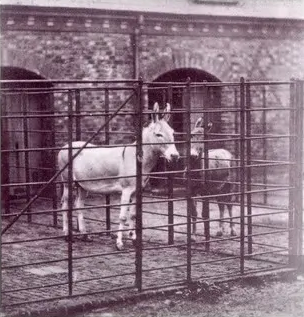
Above: London Zoo (Syrian wild ass on the right), photograph by Frederick York c.1870.


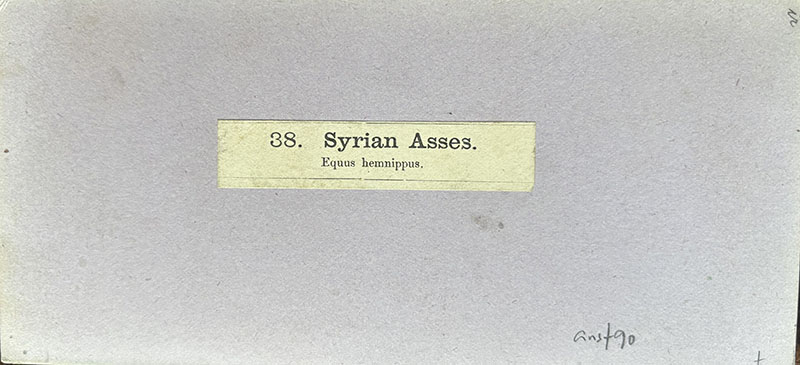
Above: London Zoo (Syrian wild ass on the right). Front and back of stereoview taken by Frederick York in Summer 1870. Held in a private collection. Photo: Ken Wallis. Reproduced with permission.
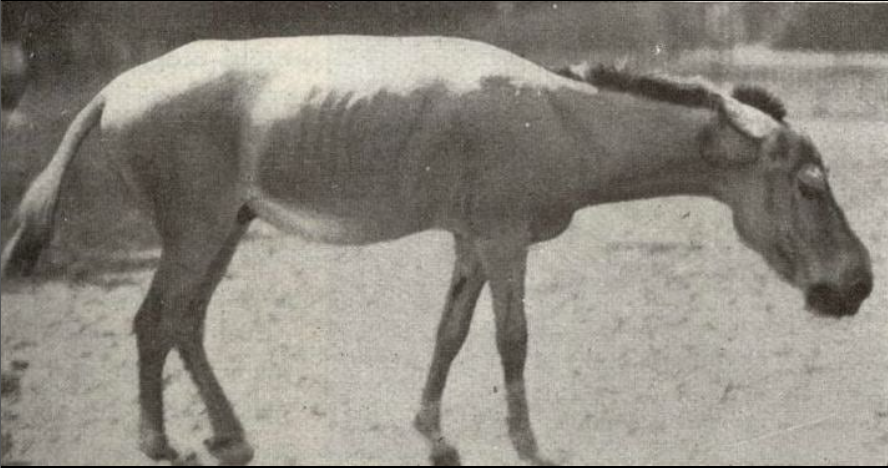
Above: Berlin Zoo, c. 1924.
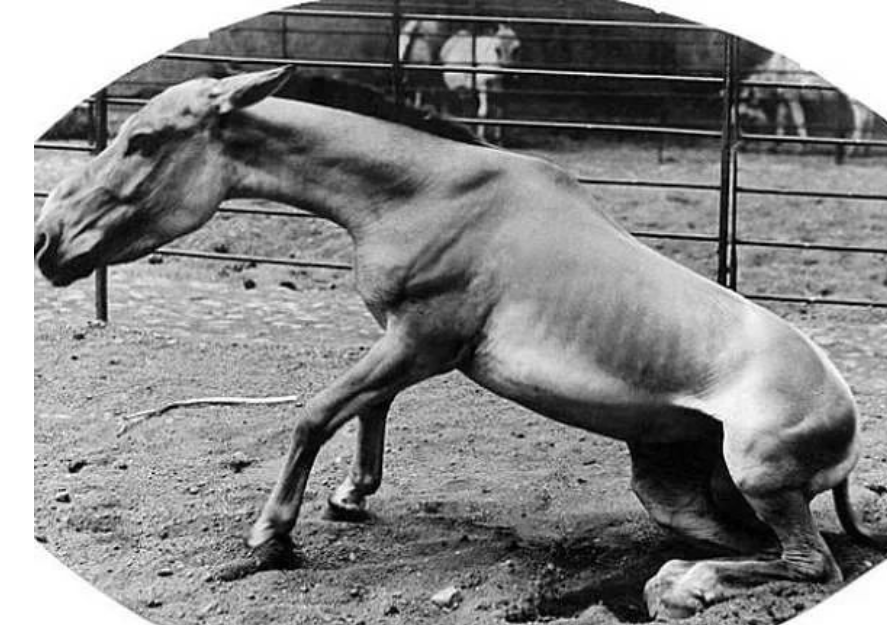
Above: Berlin Zoo, c. 1905.
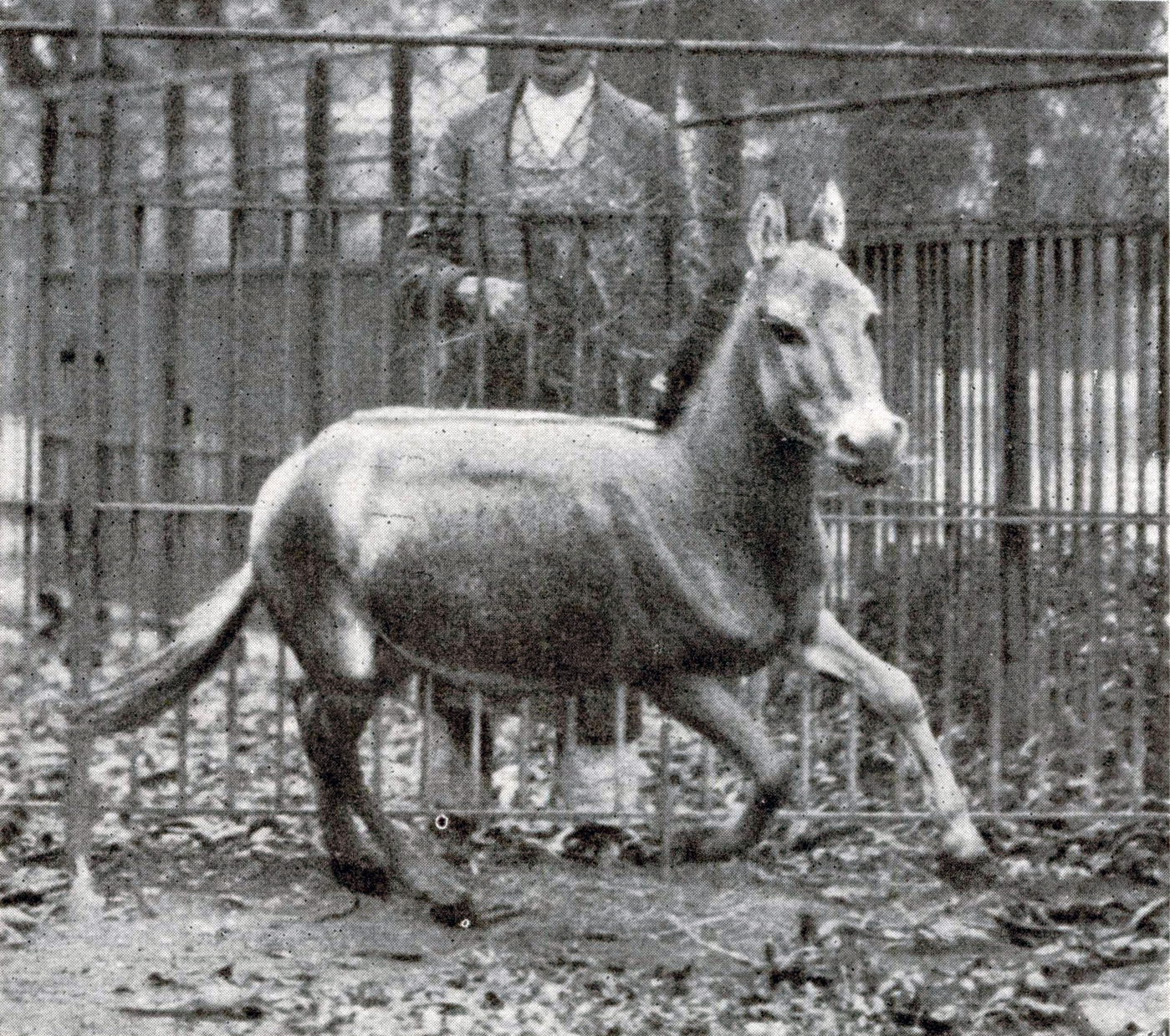
Above: Tiergarten Schönbrunn (Vienna), c. 1924.
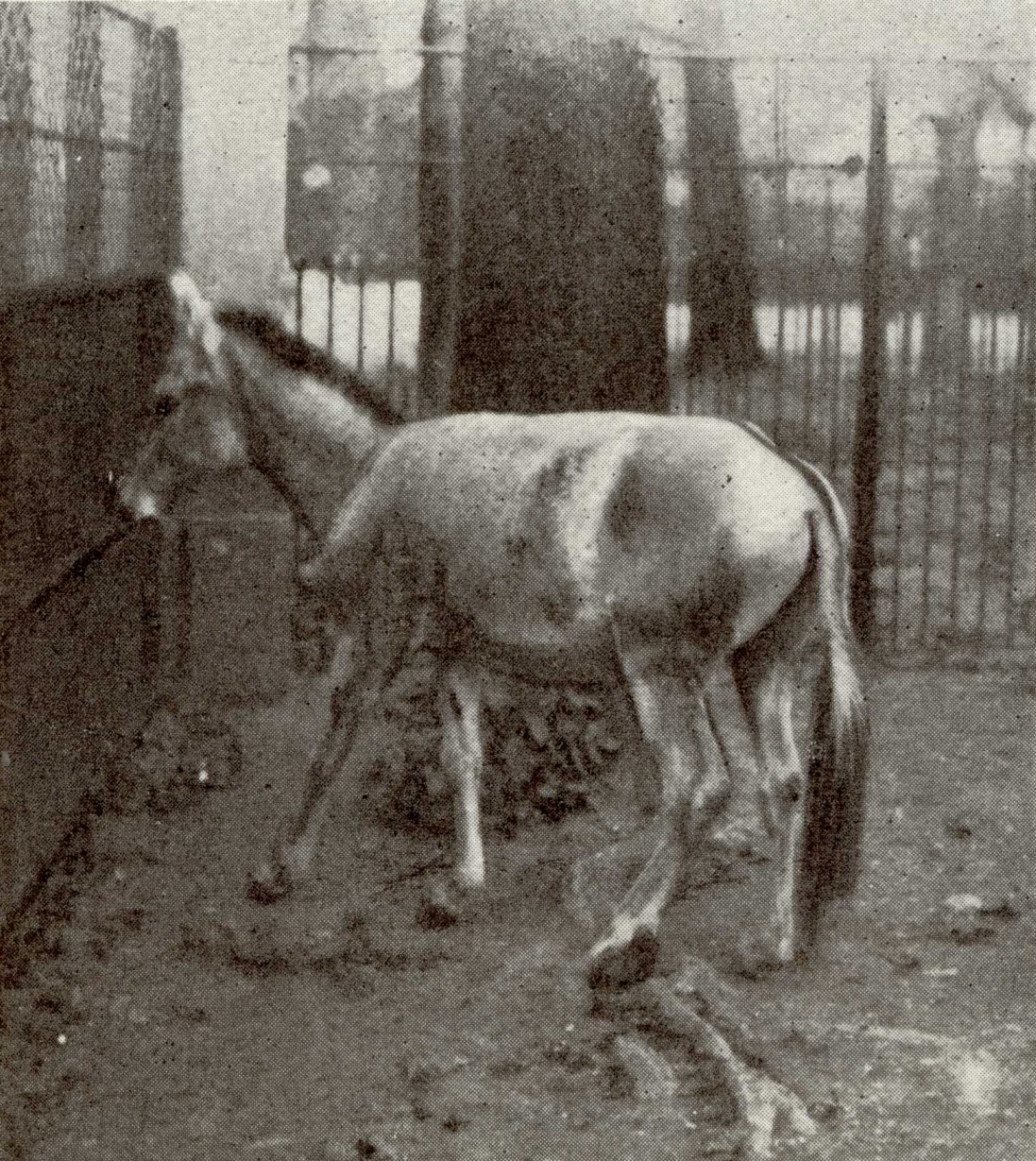
Above: Tiergarten Schönbrunn (Vienna), c. 1924.
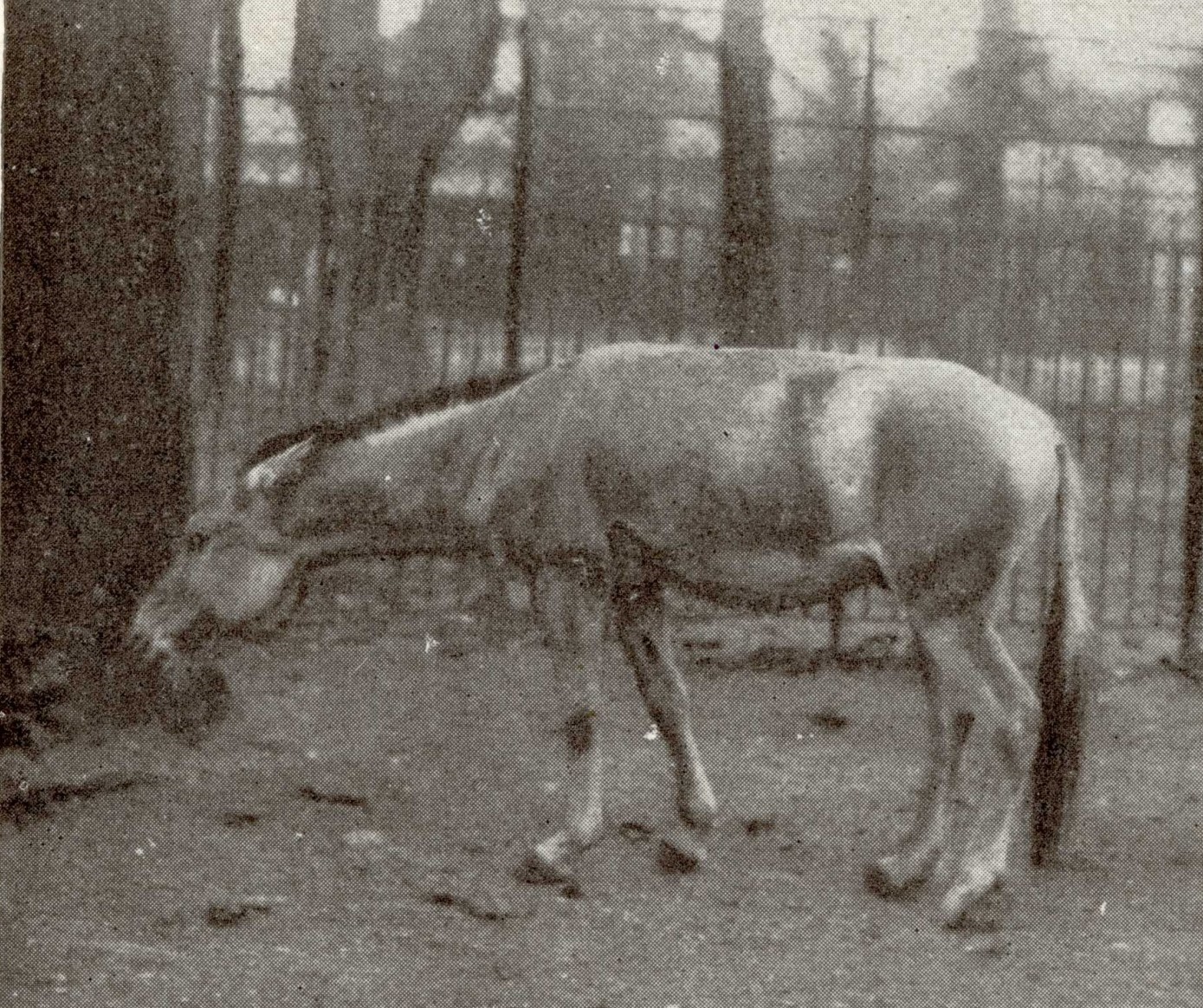
Above: Tiergarten Schönbrunn (Vienna), c. 1924.
References
Original scientific description:
Geoffroy Saint-Hilaire, I. (1855). Sur deux Chevaux d'une espèce nouvelle (Equus hemippus) donnés par S.M. l'Impératrice à la Ménagerie du Muséum d'Histoire naturelle. C.R. Acad. Sc., Paris 41: 1214-1219.
Other references:
Aharoni, J. (1930). Die Säugetiere Palästinas. Zeitschr. f. Säugetierkunde 5: 327-343.
Allen, Barbara. (Due May 2025). Lost Animals, Disappearing Worlds: Stories of Extinction. Reaktion Books. 248 pp, 38 figs.
Anonymous. (1964). A preliminary list of rare mammals including those believed to be rare but concerning which detailed information is still lacking. IUCN Bulletin 11(Special Supplement): 4 pp.
Antonius, Otto. (1928*). Beobachtungen an Einhufern in Schonbrunn. I. Der syrische Halbesel (Equus hemionus hemippus I. Geoffr.). Der Zoologische Garten 1(1-2): 19-25.
Antonius, Otto. (1938). On the geographical distribution, in former times and to-day, of the Recent Equidae. Proc. Zool. Soc. London B107: 557-564. [Abstract]
Antonius, Otto. (1939). Zur Frage der Zähmung des Onager bei den alten Sumeren. Bijd. Dierkunde 27: 477-484.
Baillie, J. and Groombridge, B. (eds). 1996. 1996 IUCN Red List of Threatened Animals. pp. 378. International Union for Conservation of Nature, Gland, Switzerland and Cambridge, UK.
Blyth, Edward. (1860). XXXI. On the different animals known as wild Asses. Journal of Natural History Series 3, 6(34): 233-254. [Abstract]
Bodenheimer, F. S. (1935). Animal life in Palestine. Jerusalem.
Bourdelle, E. (1933a). Notes ostéologiques et ostéométriques sur l'Hémippe de Syrie. Bull. Mus. Nat. Hist. Nat. 6: 435-442.
Bourdelle, E. (1933b). La position zoologique de l'Hémippe de Syrie parmi les Equidés, principalement par rapport à l'Hémione et au Cheval de Prjewalski, d'après les caractères du squelette. Congrès. Soc. Sav. 66?: 193-199.
Carruthers, Douglas. (1935). Arabian adventure to the Great Nafud in quest of the Oryx. London.
Clark, Bill. (1983). Israel restores Asiatic wild ass. Oryx 17: 113 [Abstract]
Clark, Bill and Duncan, P. (1992). Asian Wild Asses - Hemiones and Kiangs (E. hemionus Pallas and E. kiang Moorcroft). In: P. Duncan (ed.) Zebras, Asses, and Horses. An Action Plan for the Conservation of Wild Equids. IUCN/SSC Equid Specialist Group. IUCN, Gland, Switzerland. pp. 17-21.
Day, David. (1981). The Doomsday Book of Animals, Ebury Press, London.
Day, David. (1981). The Doomsday Book of Animals: A Natural History of Vanished Species. New York, N.Y.: The Viking Press.
Dorst, J. (1952). Notice sur les spécimens naturalisés de Mammifères éteints existant dans les collections du Muséum. Bull. Mus. Nat. Hist. Nat. 23: 63-78.
Eisenmann, Vera and Tranier, Michel. (1985). Découverte d'un crâne non répertorié d'hémippe Equus hemionus hemippus (Perissodactyla, Equidae) (=Discovery of an unrecorded skull of Equus hemionus hemippus (Perissodactyla, Equidae)). Mammalia 49(2): 285-288.
Goodwin, Harry A. and Goodwin, J. M. (1973). List of mammals which have become extinct or are possibly extinct since 1600. Int. Union Conserv. Nat. Occas. Pap. 8: 1-20.
Groombridge, B. (ed.). 1994. 1994 IUCN Red List of Threatened Animals. IUCN, Gland, Switzerland and Cambridge, UK.
Groves, Colin P. (1974). Horses, Asses and Zebras in the Wild. Hollywood, Florida: Ralph Curtis Books.
Groves, Colin P. (1986). The taxonomy, distribution, and adaptations of recent equids. Pp. 11–65 in: Equids in the Ancient World (eds. R.H. Meadow and H-P. Uerpmann). Wiesbaden: Dr Ludwig Reichert Verlag.
Grubb, P. 2005. Order Perissodactyla. In: D. E. Wilson and D. M. Reeder (eds), Mammal Species of the World, pp. 629-636. The Johns Hopkins University Press, Baltimore, Maryland, USA.
Harper, Francis. (1945). Extinct and Vanishing Mammals of the Old World. Special Publication No. 12, American Committee for International Wild Life Protection, New York Zoological Park, New York 60, N.Y.
Harrison, D. L. (1968). The mammals of Arabia, Vol. 2. London: Ernest Benn.
IUCN. 1990. IUCN Red List of Threatened Animals. IUCN, Gland, Switzerland and Cambridge, UK.
IUCN Conservation Monitoring Centre. 1986. 1986 IUCN Red List of Threatened Animals. IUCN, Gland, Switzerland and Cambridge, UK.
IUCN Conservation Monitoring Centre. 1988. IUCN Red List of Threatened Animals. IUCN, Gland, Switzerland and Cambridge, UK.
Lemoine, Rhys Taylor, Buitenwerf, Robert, Faurby, Sören and Svenning, Jens-Christian. (2025). Phylogenetic Evidence Supports the Effect of Traits on Late-Quaternary Megafauna Extinction in the Context of Human Activity. Global Ecology and Biogeography 34(7): e70078. https://doi.org/10.1111/geb.70078 [Supporting Information: Data S1]
Maas, Peter. (2008). Equus hemionus hemippus. Available online: http://www.petermaas.nl/extinct/speciesinfo/syrianwildass.htm [Accessed 1 January, 2013]
Malý, Radek (author), Grbavčič, Jiří (illustrator) and Dvorský, Pavel (illustrator). (2022). Atlas of Extinct Animals. Albatros nakladatelstvi as [Albatros Media]. 88/96 pp.
Mendessohn, H. (1993). Introductions and reintroductions of ungulates in Israel. International Zoo Yearbook 32(1): 144-147. [Abstract]
Milne-Edwards, H. (1869). Note sur un métis d'Hémione et de Jument, sur l'Hémippe ou Hémione de Syrie et sur l'Onagre d'Abyssinie. Nlles Arch. Mus. Hist. Nat. Paris 5: 37-42.
Moehlman, Patricia D. (ed.). (2002). Equids: Zebras, Asses and Horses. Status Survey and Conservation Action Plan. IUCN/SSC Equid Specialist Group. IUCN, Gland, Switzerland and Cambridge, UK. ix + 190 pp.
Moehlman, P.D. & Feh, C. 2015. Equus hemionus ssp. hemippus. The IUCN Red List of Threatened Species 2015: e.T7962A3144566. http://dx.doi.org/10.2305/IUCN.UK.2015-4.RLTS.T7962A3144566.en. Downloaded on 19 March 2017.
Nowak, R.M. (ed.) 1999. Walkers Mammals of the World. Sixth edition. The Johns Hopkins University Press, Baltimore and London.
Renders, E. and Vincelette, A. (2023). Methodology for the determination of modern and fossil horse gaits from trackways. Journal of Paleontological Techniques 27: 1-25.
Scott, Peter (ed.). (1965). Preliminary List of Rare Mammals and Birds, pp. 155-237. In: The Launching of a New Ark. First Report of the President and Trustees of the World Wildlife Fund. An International Foundation for saving the world's wildlife and wild places 1961-1964. London: Collins.
Tristram, H. B. (1884). The fauna and flora of Palenstine. London.
Turnbull, P.F. 1986. Measurements of Equus hemionus from Palegawra Cave (Zarzian, Iraq). Pp. 319–365 in: Equids in the Ancient World (eds. R.H. Meadow and H-P. Uerpmann). Wiesbaden: Dr Ludwig Reichert Verlag.
http://extinctanimals.proboards.com/thread/7725/equus-hemionus-hemippus-syrian-wild
* 1929?
Acknowledgements
I am very grateful to collector Ken Wallis for provisioning me with information about Frank Haes' two series of photos from London Zoo (from 1864 & 1865). And for allowing me to reproduce his photographs (front and back) of the stereoviews.

